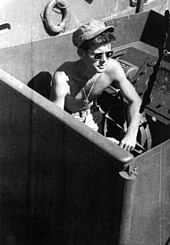On August 2, 1943, Kennedy's boat, PT-109, along with PT-162 and PT-169, were ordered to continue nighttime patrol near New Georgia in the Solomon Islands,[16] when it was rammed by the Japanese destroyer Amagiri.[17] Kennedy gathered his surviving crew members together in the water around the wreckage, to vote on whether to "fight or surrender". Kennedy stated, "There's nothing in the book about a situation like this. A lot of you men have families and some of you have children. What do you want to do? I have nothing to lose." Shunning surrender, the men swam towards a small island.[18] Kennedy, despite re-injury to his back in the collision, towed a badly burned crewman through the water with a life jacket strap clenched between his teeth.[19] He towed the wounded man to the island and later to a second island from where his crew was subsequently rescued.[20] For these actions, Kennedy received the Navy and Marine Corps Medal with the following citation:
For extremely heroic conduct as Commanding Officer of Motor Torpedo Boat 109 following the collision and sinking of that vessel in the Pacific War Theater on August 1–2, 1943. Unmindful of personal danger, Lieutenant (then Lieutenant, Junior Grade) Kennedy unhesitatingly braved the difficulties and hazards of darkness to direct rescue operations, swimming many hours to secure aid and food after he had succeeded in getting his crew ashore. His outstanding courage, endurance and leadership contributed to the saving of several lives and were in keeping with the highest traditions of the United States Naval Service.General Douglas MacArthur, however, had quite a different opinion about Kennedy's actions: "Those PT boats carried only one torpedo [sic]. They were under orders to fire it and then get out. They were defenseless. Kennedy hung around, however, and let a Japanese destroyer mow him down. When I heard about it, I talked to his superior officer. He should have been court-martialed."[21]
In October 1943, Kennedy took command of a PT boat converted into a gun boat, Motor Torpedo Boat PT-59, which in November took part in a Marine rescue on Choiseul Island.[22] Kennedy was honorably discharged in early 1945, just prior to Japan's surrender. Kennedy's other decorations in World War II included the Purple Heart, American Defense Service Medal, American Campaign Medal, Asiatic-Pacific Campaign Medal with three bronze service stars, and the World War II Victory Medal.[2] Kennedy privately admitted he didn't feel that he deserved the medals he had received because the PT-109 incident had been the result of a botched military operation that had cost the lives of two members of his crew. When later asked by a reporter how he became a war hero, Kennedy joked: "It was involuntary. They sank my boat."[23]

0 comments:
Post a Comment